In most general terms, cancer can be characterized as uncontrolled cell replication. Regardless of its type, cancer initially develops in a normal, healthy cell and shares the basic characteristics of this normal cell, at least in its early developmental stages. However, these cells tend to lose some of their abilities. One such important ability is that of reacting to the messages delivered by their surrounding or their own organisms that regulate cell replication. When such a disorder occurs, the cell can no longer control its replication and the growth of tissues. This process, known as "continuous dividing," is genetically transferred to new cells resulting in the spread of tumours, which in turn invade the neighbouring tissues. These decomposed cells eat up the nutrients of other cells, consuming the vital amino acid supply. Cancer cells eventually shut down the passages within the human body with their expanding volume. They accumulate in various organs such as the brain, lungs, liver, and kidneys, surrounding the healthy and normal cells of these organs and preventing their normal functioning, eventually posing a serious threat to human life.
Normal cells replicate only when they receive a command from neighbouring cells. This is a safety measure within the organism. However, cancer cells do not respond to this mechanism and refuse any control over their replication system. The type of cancer described so far does not create any problem for the defence system. A strong body with an effective defence system is capable of struggling with the increasingly expanding cancerous cells multiplying in number, and of even defeating the disease. The main problem arises when cancer cells pierce their own membranes with the help of an enzyme (pac-man enzyme), and mix in the circulatory system (the conveyor network) of the body by penetrating the lymphatic fluid, and eventually reaching distant tissues and cells.
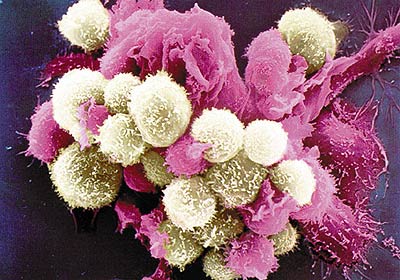 | 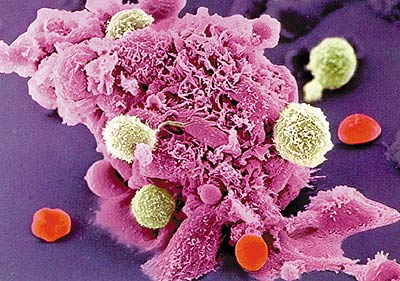 |
| A war between the cancer cell (pink) and lymphocytes (yellow) | |
The current scenario is quite negative. Cells that used to work collectively in providing humans with the gifts of seeing, hearing, breathing, and living suddenly grow recalcitrant, not obeying the "stop" command they receive from neighbouring cells. As they continue replicating, they carry out a destruction process at full blast which leads to the total death of the body.
If we compare the human body to a country and the human defence system to a powerful, fully equipped army, the cancer cells emerge as the rebels of this country. This mutinous community grows in number daily, continuing their demolition of the current structure. But the army of this country is not at all pregnable.
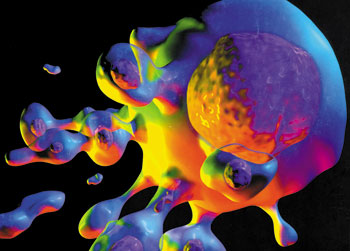 |
| When required, the cell commits suicide in a disciplined manner. |
The macrophages, the front line warriors of the defence system, surround the invader when they encounter it and destroy the cancer cells with the help of a protein they specially produce. In addition, the T cells, the strong and intelligent warriors of the defence system and their exceptional weapons (antibodies) kill the cancer cells that have begun to fuse in the body and lymphatic fluids by piercing the cell membrane. The struggle will continue even as the cancer spreads. As the cancer cells develop further, the defence cells help to inhibit the progress of the disease, resulting in remission.
One of the systems within human cells which prevent the spread of cancer cells is "apoptosis", which causes the suicide of the cell. Apoptosis is seen when the DNA of the cell is damaged, or a tumour develops, or the effectiveness of the P53 gene — also known as the "cancer preventing gene" — lessens. Though apoptosis may appear to be a very negative event, it is actually highly important, as it blocks such vital disorders and prevents the disease from passing on to the next generation. When compared to the potential danger imposed by the cancer cells, which are likely to damage the entire human body, the loss of a single cell is much more acceptable. Cells within the human body that realize (!) that there is a disorder in their own structure threatening the human body instigate their own demise to prolong human life.
The cancer takes on a life-threatening form when these decomposed cells overcome this suicide system. In this case, a second defence mechanism is activated to avoid uncontrolled multiplying of these cells. If they succeed in surpassing this barrier, too, they then encounter a further stage known as the "the term of crisis". At this stage, the cells, which have successfully escaped from the previous security systems, are killed en masse. Among these cells, one cell, however, succeeds in overcoming the "crisis". This "rebellious" cancer cell will transfer its rebellious nature to its descendants, which will multiply in great numbers. The cancerous patient must now fight an intensive struggle with cancer.
Is it only the uncontrolled, independent and continuously multiplying nature of the cancer cell that brings victory to it? Other reasons lie behind this success.
Cells carry a type of inscription system on their surface which positions them in the body. This inscription system is decipherable by all the cells within the human body, helping each cell to know exactly where it belongs and preventing it from occupying another’s place. This system ensures the integrity of the tissues. Cells, which are aware of their position, neither go anywhere else, nor let any other cell occupy their place, thus ensuring the maintenance of the body in a healthy state. Cells that are not located at a certain site or those located at an inappropriate site will eventually commit suicide. However, with the help of this system, the suicide process is totally eliminated, as the cells are not allowed to be dislocated or located in an inappropriate site. This process is not as simple as it may seem. In order to maintain the effective functioning of this system, each cell has to identify its own position whilst respecting the locations of other cells, and being mindful not to invade their sites. These procedures are taught to them by various mediator molecules which enable these cells to maintain their respective places. However, there are occasions when these mediator molecules are absent or unable to fulfil this duty. This provides the cancer cells with an advantage. When inhibitory molecules are not present in the environment, cancer cells spread more rapidly. Besides, cancer cells are not required to anchor themselves to any specific site. They undermine the rules by living independently and without settling in any place.
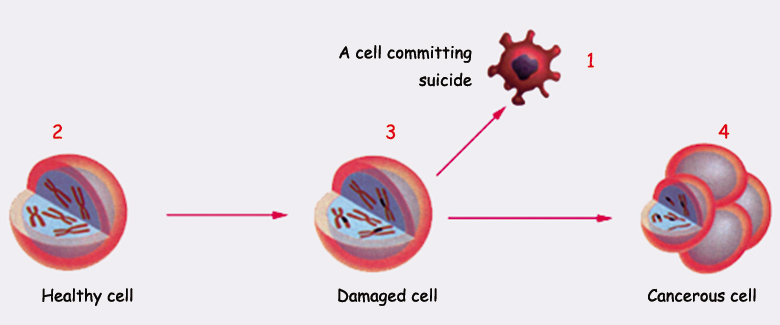 | |
| 1. A cell committing suicide | 3. Damaged cell |
| The process by which healthy cells transform into cancer cells. A normal cell as seen at the left either commits suicide or transforms into a cancer cell as it undergoes various genetic mutations. | |
Erythrocytes are exceptional cells that do not possess a stationary site within the human body. They pierce the membranes of other cells and tissues and tear down the obstacles with the aid of a special enzyme called "metallo-proteinase". They are therefore able to visit any part of the human body at will. The defence cells use this enzyme to reach out to the enemy cells, while cancer cells use them for an entirely different purpose. Their main goal is to attack healthy cells and invade them.
The skills of the cancer cells are not limited to these pursuits; they are also capable of playing other ‘games’ against the defence cells. Odd as it may sound, we are not talking about talented actors but rather cancer cells, which play games against their opponents. Before attempting to explain these unbelievably clever games, let us review what we have explained so far.
Isn’t it extraordinary that our army of defence sets up progressive barriers against the enemy? This organization we call an "army" is made up of cells which can only be viewed under an advanced electron microscope. Their ability to protect and guard their sites, their willingness to lay down their own lives to save the life of the human body they belong to, their unyielding commitment to continue their struggle, are not the products of coincidence. Undoubtedly, we can see a very conscious and well-organized form of functioning in defence cells.
What would happen if such a difficult mission were handed to a trillion highly educated humans beings? Would the success rate be as impressive? Would it be possible for them to enforce their will on the crowd despite the existence of strict disciplinary rules and obligatory measures? If a few of these individuals forgot the formula of the antibodies they were supposed to manufacture, or neglected to manufacture them, or refused to commit suicide when necessary, would all of these stages function regularly? Would the struggle end with victory? Could an army of billions of individuals continue its struggle without any mistake? Are there, by any chance, any brave and skilled commanders or managers who would be willing to undertake the responsibility of keeping these billions under control? However, our defence cells do not need any commanders or managers. Their system operates in a very regulated manner, without any inhibitions or difficulties. There is no anarchy or confusion during the process. The reason for this perfection and extremely effective functioning is Allah, Who established this system down to its minute details and inspired the elements of this system to fulfill their responsibilities. In the 5th verse of Surat al-Sajda, it is stated: "He directs the whole affair from heaven to earth."In accordance with this rule, the defence cells continue their struggle without rest or duress with this inspiration given to them by Allah.
It must not be forgotten that cancer cells are original body cells that carry the molecular character of the human being. In consequence, it is difficult for the defence cells to identify cancer cells. Furthermore, cancer cells manage to win over some antibodies by a method undiscovered to date.
As we have mentioned, antibodies are a type of protein that stops the activities of enemy cells. However, for some unknown reason, cancer cells are adversely affected by the antibodies. Instead of stopping, their activities increase, resulting in the rapid and forceful spreading of the tumour.
Antibodies, which bind themselves on to the surface of the cancer cell, "collaborate" with the cancer cell in a sense. Other antibodies do not touch a cancer cell having an antibody attached to it. Hence, the cancer cell is perfectly camouflaged.
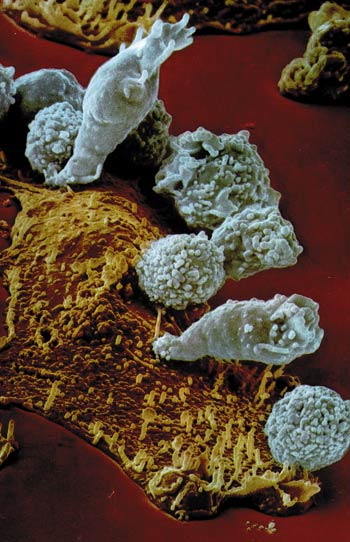 | 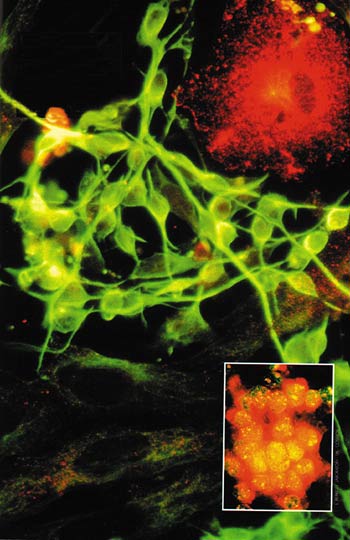 |
| A breast cancer cell and at the top a dermal cancer cell | Cancer cells do not act alone. There are many cells that communicate and collaborate with them. |
Collaboration between antibodies and cancer cells can reach even broader dimensions. There are also occasions where cancer cells combine with antibodies to form "pseudo supressor T cells". These pseudo suppressor T cells misinform antibodies by relaying the message that there is "no danger". More sinister situations also develop whereby the cancer cells develop into "Pseudo Helper T cells" instead of the pseudo suppressor T cells. In such situations, the message is delivered to a bigger number of antibodies. There can be no more convenient environment possible for the development of cancer cells.
Additionally, cancer cells may sometimes spread "trap antigens" in order to protect themselves from a possible attack by the defence system. These tumours spread out such large amounts of antigens from their surface that the blood stream is inundated with them. These antigens, however, are fake and cause no harm to the human body. However, the antibodies are not aware of this and they respond without delay by instigating a war against them.
During this chaos, the real and dangerous cancer cells continue to function, going undisturbed and undiscovered by the enemy.
 |
| An AIDS virus (orange) attempting to enter a T cell by piercing the cell membrane. |
In the previous chapters we discussed viruses and explained the importance of their role in the life of humans. Among these viruses, the most dangerous and harmful is the "HIV virus", which has preoccupied researchers for a long time and may well continue to do so for some time to come. Unlike other viruses, this micro organism totally inactivates the defence system. It is impossible for a human being with a malfunctioning defence system to survive.
The HIV virus causes irreversible damages to the human body by causing the defence system to collapse, making it vulnerable to all kinds of diseases, eventually giving rise to various fatal conditions. It has occupied researchers for many years, resulting in a sense of desperation and hopelessness. The Journal of Bilim ve Teknik (Science and Technology), published in August 1993, made the following statement:
"The more we learn, the less certain we become." This statement is the most common answer to a public survey carried out among 150 of the most recognized researchers worldwide, studying AIDS. This was published in the weekly scientific journal Science. No one can make certain judgments based on the theses that have been advocated for years. Views, which were considered absolutely correct are now being pushed aside after they have been revealed to rely on shaky grounds. Inevitably, the end result is such that even long established theories about AIDS and its effective cause, the HIV virus are once again being reviewed and their validity being questioned. 11
With the passage of time, the issues have intensified rather than become resolved. To date there remains numerous unanswered questions, and the advent of new inventions has served only increase the number of these unanswered questions. AIDS still remains a mystery for mankind.
One of the most important facts known about the HIV virus is that it enters only some and not all the cells of human beings. Its main target is the helper T cells, which are the most effective elements of the defence system. This is a very important point. Among numerous types of cells, the virus chooses those cells of the defence system which are, in effect, the most beneficial for it and this instigates the destruction of the human body.
When T cells, the vital elements of the defence system, are seized, the defence system is deprived of its brain team, and is no longer able to recognize the enemy. This could be regarded as an ingenious war tactic. An army without any effective communication and intelligence systems would be considered to have lost its main strength.
Furthermore, the antibodies produced by the human body do not harm the AIDS virus. AIDS patients continue to produce antibodies, however, they are not as effective in the absence of the killer T cells.
One unanswered questions is: How does the HIV virus know exactly what target to focus on? By the time the AIDS virus understands that the T cells are regarded as the "brains" of the defence system, it will be destroyed by the existing system immediately upon entering the human body. However, it is impossible for the AIDS virus to conduct any form of intelligence surveillance prior to entering the human body. How then has the AIDS virus developed this strategy?
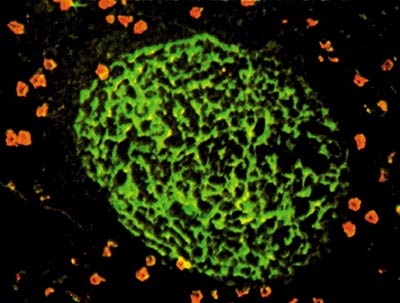 | 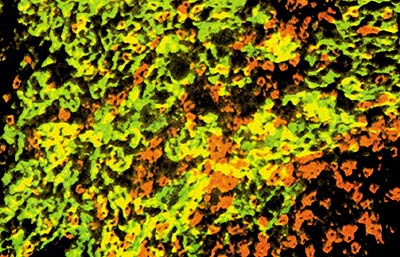 |
| In the picture above you can see a healthy lymph node | This picture shows a lymph node damaged by the AIDS virus. |
This is only the first of many amazing skills mastered by the AIDS virus.
At the second stage, the virus has to attach itself to the cells which it has set as a target for itself. This procedure is not at all difficult for the AIDS virus. In fact, it attaches to these cells as a key fits into its lock.
At the third stage, the HIV virus undergoes a series of miraculous processes, which will ensure its longevity.
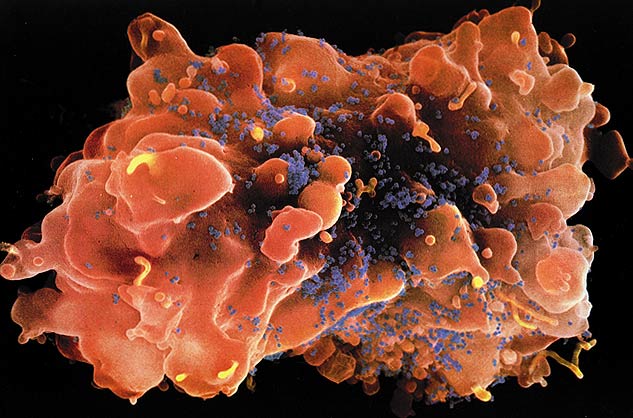 |
| Before moving on to the other cell type to be infected, small pieces of the HIV virus (blue) multiply in the defence cells. Although the defence cells are able to deal with the HIV virus initially, the HIV virus eventually takes over. The reason for this phenomenon remains unclear. |
The HIV virus is a retrovirus. This means that its genetic make-up contains solely RNA and no DNA. But a retrovirus needs DNA to remain alive. To provide this, it has recourse to a very interesting method: it uses the nucleic acids of its host cell and converts its RNA into DNA by means of an enzyme called "the reverse transcriptase", meaning it will reverse the process. Then it places this DNA in the DNA found in the nucleus of its host cell. The inheritance material of the virus has now become the inheritance material of the T cell. As the cell multiplies, so does the HIV virus. The cell starts to work as a factory for the virus. But invading a single cell does not satisfy the HIV virus. It will eventually attempt to seize the whole body.
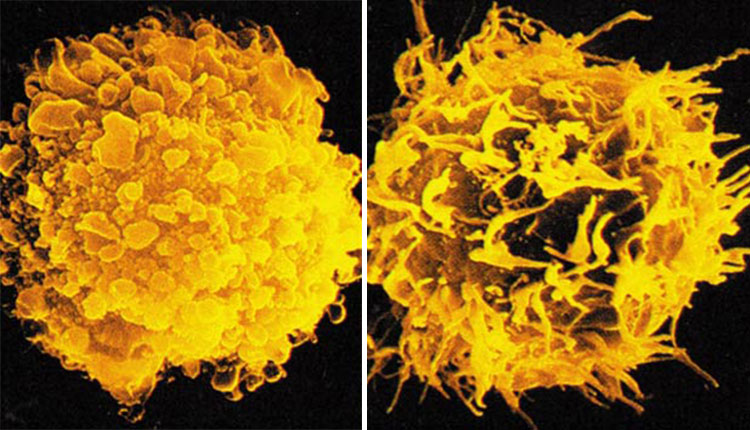 | |
| (Left) A healthy T cell. | (Right) These images are magnified more than 3000 times. |
Then the fourth stage comes. The initial HIV virus and others want to leave their host cells and invade other cells to facilitate their extraordinary proliferation. They do not expend much effort in doing so. Everything takes place at a natural pace. The membrane of the invaded T cells cannot tolerate the pressure of the multiplication process, and is riddled with holes, allowing the HIV viruses to get out of the cell to seek alternative hosts. As the HIV virus increases in number, it also kills its host T cell.
The successful HIV virus has now completely seized the human body. Unless mankind succeeds in discovering an effective cure to beat this virus, it will remain there. It is entirely at the discretion of the HIV virus either to lie dormant for many years, or instigate an immediate attack on the human body.
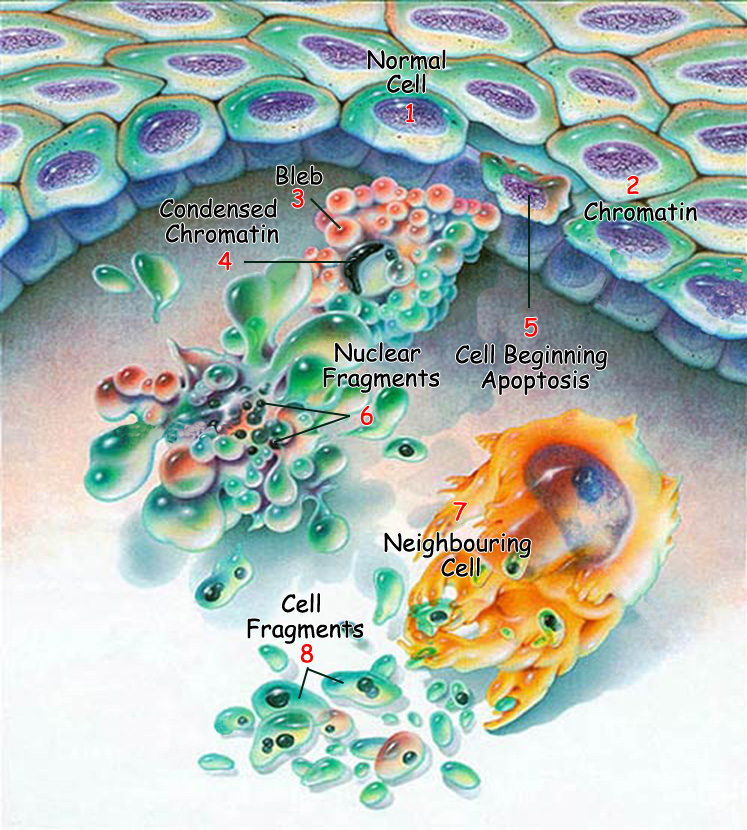 | |||
| 1. Normal cell | 3. Bleb | 5. Cell Beginning Apoptosis | 7. Neighbouring Cell |
| Although they are not infected, the T cells of AIDS patients die by passing through all the stages of apoptosis. Mounting an immune response against an intruder virus, helper T cells multiply. These T cells die in a few days after they have fulfilled their function. However, many healthy T cells of AIDS patients commit suicide before attempting to struggle with the infection. First the cell shrinks and pulls away from its neighbours (top right). Then blebs appear on the surface (making the cell appear to boil), and the chromatin (nuclear DNA complexed with proteins) condenses at the edges of the nucleus. Soon the nucleus, and then the cell itself, breaks up, and the cell fragments are quickly ingested by other cells in the vicinity. | |||
After entering the human body, the HIV virus can produce up to ten billion viruses a day. The excessive number of viruses produced in one day is unmanageable, despite the technological advancements of the day. The HIV virus cannot be considered as a simple structure. What we have here is a micro-organism, so advanced and intelligent that it can duplicate millions of its own copies, possesses a plan to capture its host cell, and is able to cause the death of a huge human body.
In addition to the abilities of the HIV virus mentioned above, the HIV virus is also able to assume varying forms in an attempt to prevent its capture by the defence system. This makes the HIV virus immune to the effects of medications aimed at treating it today. Modern medicine has attacked the virus with a variety of medications at the same time and barely succeeded in dealing with the resistance of the virus. Although the virus is partially eradicated, the only positive outcome has been the prolonging of the patients’ lives to a limited extent.
It is of great interest how a virus like the HIV virus can regenerate itself when faced with the danger of being eradicated. Scientists are left helpless in the presence of such skillful tactics.
These are not the only mind-boggling tactics used by the HIV virus. helper T cells circulating in the bloodstream swim along, interlocking with one another like the metallic projections of a zipper. The HIV leaps from one T cell to another to avoid contact with the antibodies in the blood stream. All this is done by a virus, which is only one micron in size, possesses no DNA and cannot even be qualified as a living creature. The extraordinary ability of the HIV virus to recognize the human body so well, develop advanced systems to overcome the human body, implement the necessary strategies without any errors and constantly modify itself to be protected from all kinds of weapons used by the body are all truly amazing. This is a very good example of how helpless mankind is rendered in the presence of a minute virus, which cannot be seen with the naked eye.
11. Bilim ve Teknik Dergisi (Journal of Science and Technology), Vol 26, No 309, August 1993 p. 567